Introduction
In the dynamic landscape of academia in 2024, we’re faced with an ever-growing student population and diverse course offerings: public college enrollment is predicted to rise from 13.86 million in 2023 to 14.78 million by 2030, and there are already over 80 types of bachelor degree. Efficient scheduling is only going to become more challenging and critical in the coming years.
Now let’s consider this: the average student dedicates around 15 hours a week to preparing for class. Coupled with the significant uptick in online learning evident.
To meet these needs, consider platforms like the Virto Calendar app for education. More than mere digital planners, these software tools are designed to enhance and simplify the academic journey for both institutions and their students. In this guide, we’ll delve into the functionalities and benefits of some of the best scheduling software options, offering insights to help you make an informed choice. For educators, IT professionals, or anyone keen on refining school scheduling processes, the developments in education scheduling software in 2024 hold promise. Let’s explore together!
The Challenges of School Scheduling
Coordinating a school’s schedule might sound straightforward, but when trying to meet the varied needs of students, faculty, and courses, things can get complicated.
First up, there’s course conflicts. With so many subjects and disciplines available these days, overlapping course timings has become a routine issue. This limits what students can opt for and can also affect their academic journey. Think about a student wanting to study both astrophysics and literature only to find they’re offered in the same time slot. This can lead students to make difficult choices, often missing out on subjects they’re passionate about.
Next, there’s resource allocation. Making sure classrooms, labs, sports facilities, and faculty are all available when needed is a task in itself. And it’s not just about finding a spot; it’s about finding the right spot. Putting a computer science class in a regular classroom when they need a lab, for instance, can lead to obvious issues.
Personalized learning is becoming the norm, and while it offers many benefits, it introduces its own set of scheduling complexities. Creating timetables that cater to individual learning requirements while ensuring faculty aren’t overloaded is a tightrope walk. And for students with specialized programs or needing extra academic support, aligning their schedules with standard timings can be a challenge.
Extracurricular activities add another layer of complexity. Schools have a vibrant array of clubs, sports, and other communities, all of which are essential for a complete education. The trick is to make sure these don’t clash with academic sessions and can accommodate varied student interests.
And let’s not forget the faculty. Irregular schedules can mean they’re either packed with back-to-back sessions or left with long, idle breaks. This not only affects their teaching efficiency but can also lead to burnout.
With all that said, while school scheduling has its fair share of intricacies, these are not necessarily serious obstacles. As we delve deeper into education scheduling software, we’ll see that technology offers clear solutions to these challenges for colleges.
The Benefits of School Scheduling Software
Technology has become a key part of every industry, and it’s brought significant changes to the world of education. One of the standout innovations for educational institutions is software for class scheduling. This software simplifies school scheduling tasks and greatly improves the scheduling experience. Let’s get more specific:
- Improved efficiency: One of the most immediate benefits of adopting school scheduling software is the sheer efficiency it brings. Gone are the days of manually combing through timetables, trying to match teachers to classes without overlap. With a few clicks, administrators can generate smart schedules that make the best use of resources and time.
- Reduced errors: Human error is natural, especially when juggling countless classes, teachers, and students. However, these mistakes can lead to disruptions. With college scheduling software, the chances of overlooking a clash or double-booking a room are substantially reduced. Automated checks ensure that any potential issues are flagged before finalizing the schedule.
- Improved student experience: A streamlined schedule directly correlates with a better student experience. No longer will students need to dash from one end of the campus to another for classes. Scheduling software can be programmed to consider logistics, ensuring optimal class allocations. This leads to less rushing and increased attendance in general.
- Flexibility and adaptability: In the ever-evolving educational landscape, flexibility is crucial. Whether it’s accommodating a new course or adjusting for a faculty member’s sudden absence, scheduling software allows for rapid and seamless updates. This adaptability helps the institution to quickly respond to unexpected changes without causing disruption.
- Data-driven decisions: As well as just scheduling, these software solutions often come equipped with analytics. Schools can gain insights into course popularity, resource utilization, and student preferences. By analyzing data, institutions can make informed decisions about future course offerings, faculty hiring, and infrastructure improvements.
- Transparent and rapid communication: Modern scheduling software often includes communication tools. If a class gets rescheduled or moved to a different room, notifications can be instantly sent out to affected students and faculty. This level of real-time communication minimizes confusion and ensures everyone is always on the same page.
College scheduling software goes beyond being a mere tool—it revolutionizes the academic landscape. It directly addresses the issues educational institutions face, leading to a positive educational experience.
Types of School Scheduling Software
School scheduling software is pretty versatile these days. Although it used to focus on specific tasks, most now bundle a bunch of features together. This helps schools run smoother, avoids scheduling hiccups, and ensures everyone—from teachers to students—has what they need. Let’s delve into the top categories:
1. Software for class scheduling
This type of tool revolves around managing individual classroom schedules. By mapping out room capacities, facilities, and equipment, it ensures each space is used to its fullest potential. For example, a literature class might settle comfortably in a traditional classroom, while a biology lesson requiring specific equipment will need a lab. Managing these needs efficiently ensures no classroom is overbooked while another sits empty.
2. Course scheduling software
This is all about the bigger academic picture. It’s like the production manager, ensuring everything’s set for the main performance. By juggling data such as faculty availability, student course demands, and other logistics, it crafts a comprehensive course layout for the academic term. So if someone’s keen on diving into both modern art and quantum physics, this software ensures those classes don’t clash, making course registration easy.
3. Student scheduling software
Personalization is the buzzword here. Students input their course choices, extracurricular activities, and other commitments, and out pops a tailor-made timetable. As well as academics, it factors in other aspects of student life—from work schedules to soccer practices. It’s a boon especially for institutions offering a wide range of electives and activities.
4. Resource allocation software
While not strictly a scheduler, this one is an unsung hero. Imagine it as the caretaker of a grand mansion, ensuring each room is used for its rightful purpose. From allocating computer labs for group projects to earmarking the auditorium for the big school play, it makes sure each resource finds its perfect match.
Each of these software types addresses specific challenges faced by schools. As technology evolves, these tools become even more integrated and intuitive, further simplifying the tricky task of academic scheduling.
How to Choose the Right School Scheduling Software
When choosing scheduling software for schools, it’s crucial to remember that not every tool will fit your needs. Here’s our advice for making sure you select the best solution.
The budget balancing act
While we might dream of the Rolls-Royce of scheduling software, sometimes our budget is more suited to a cozy compact car. And that’s perfectly fine! Start by understanding your financial limits. There are some terrific options out there that won’t break the bank, and many providers offer tiered pricing based on features or user numbers. But remember, sometimes a bigger investment upfront can save costs down the line with fewer hiccups.
Thinking big (even if you’re small… for now)
Today’s cozy community college could be tomorrow’s state-sized university campus. So while you’re looking for solutions to suit your current size, keep the future in mind. Your chosen software should be able to grow with you, enabling you to add features or accommodate more students without a complete overhaul. Choose software that’s like a modular office space—adaptable and ready to evolve with your growing needs.
A supportive safety net
The transition to a new system can feel a bit like learning to ride a bike. There’ll be wobbles, maybe a scraped knee or two. That’s where stellar customer support comes in, like a reassuring hand on your back. Look for providers with robust training programs, responsive help desks, and maybe even an online community where you can seek help and exchange tips with other users.
Demos and testimonials
Demos are your sneak peek into what it’s like to use the product. Use them to get a feel for the software’s user-friendliness and how it might fit into your institution’s workflow. And don’t just take the company’s word for it. Search for reviews and testimonials. Hearing from others who actually handle school scheduling can give really useful insights.
Features to Look for in Scheduling Software
Choosing the perfect software for class scheduling might seem like a simple task on the surface. But with numerous options available, what features should you prioritize? Let’s break it down:
Ease of use
Imagine software that anyone, even those less technologically inclined, could breeze through. That’s the goal. It should feel as intuitive as flicking on a light switch, allowing users to harness all its features effortlessly.
Playing well with others
Any college will have several systems—from student databases to learning management systems (LMSs). The best scheduling software should gel with them like they’ve been created by the same developer team.
Tailor-made solutions
No two schools are the same, so the ideal software should be like a well-tailored suit, adapting to specific requirements such as tweaking time slots or accommodating unconventional course designs.
Staying current
Things change—a lot. And when they do, software should keep pace, updating schedules in real time. This ensures everyone, including students, faculty, and admin staff, remains on the same page.
Access from everywhere
Imagine making vital schedule updates from a café or your living room. With cloud-based software, this isn’t just a dream but a very achievable reality, ensuring utmost flexibility.
Stellar support
New software often feels like a new toy. Exciting, but tricky to figure out at the beginning. That’s where top-notch training and support step in, turning the learning curve into a gentle slope.
Future ready
Schools change, grow, and evolve. Software should too. It should be able to scale up or down based on ever-shifting needs to stay relevant through the years.
Having a list of top features is great, but what truly sets the best scheduling software apart is its tangible impact in the real world. In the next section, we’ll review the top software for class scheduling.
Top School Scheduling Software in 2024
Google Classroom
Overview:
Google Classroom is a free online tool that lets educators manage coursework, distribute assignments, and communicate with students all in one place. Designed to make teaching more productive and meaningful, it’s loved for its user-friendly interface and seamless integration with Google services. Thanks to these integrations, users can schedule classes using Google Calendar. To learn more about how to do this, visit the official guide.
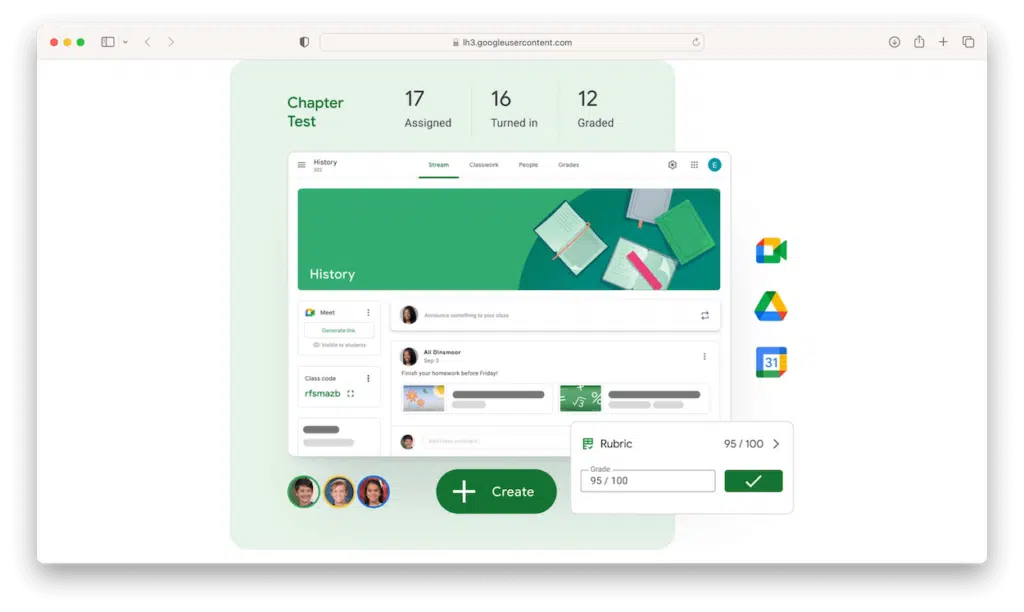
Availability:
Google Classroom is available on the web and as a mobile app for Android and iOS.
Testimonial:
I have been using Google Classroom in my middle and high school classrooms since its early beta stage. I can tell you with 6 different preps in a school day, this is a great way to keep myself and my students organized and on task.
John (Capterra review)
Highlights:
- Streamline classwork: Organizes assignments, questions, and materials in a structured manner, making it easy for students to find their tasks.
- Originality reports: Detects potential plagiarism by comparing student work against billions of web pages and tens of millions of books.
- Integrated Google Meet: Lets teachers initiate live virtual classes directly within Google Classroom, making the transition from classwork to virtual instruction seamless.
- Grade importing: Facilitates grade transfers from Google Classroom to the School information system, streamlining the grading process.
- Teacher feedback tools: Allows educators to annotate and comment directly on student assignments, so they can provide specific feedback and facilitate revision and learning.
Virto Calendar App for Education
Overview:
Blending the best of Microsoft 365 with the convenience of calendars, Virto Calendar does the heavy lifting. It seamlessly syncs with products such as Microsoft Outlook, iOS, Google Calendar, and any other internet calendar. The outcome? All your scheduling needs, academic or admin, under one user-friendly roof. Think of it as your go-to personal assistant for schedules and deadlines.
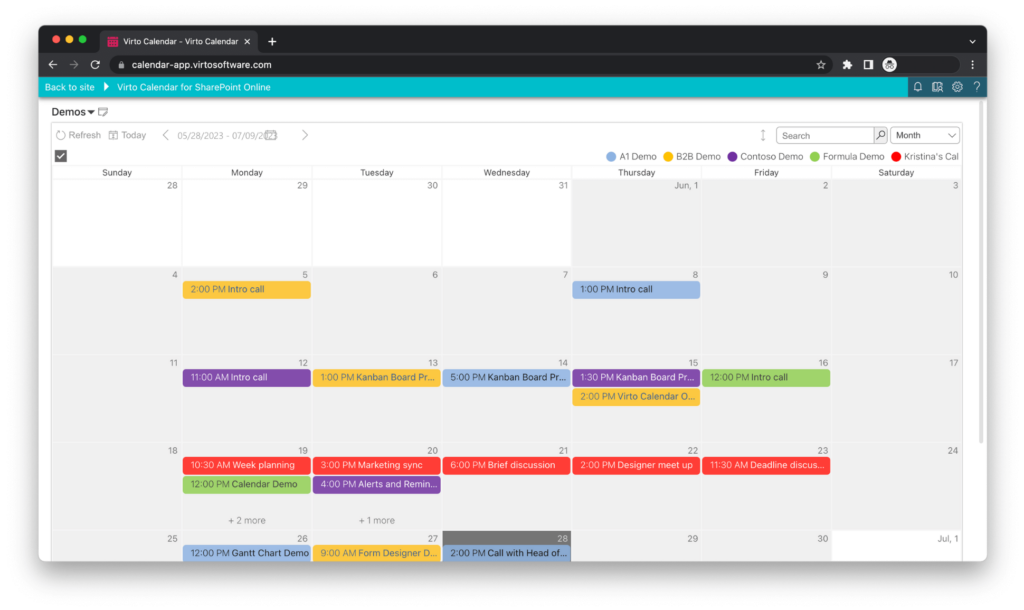
Availability:
Available as web-based class scheduling software, the Virto Calendar app integrates effortlessly with the Microsoft 365 environment, including SharePoint and Microsoft Teams. It can be opened in your browser or in Teams on any mobile or tablet.
Testimonial:
An incredibly useful tool for overlaying professors’ appointments, course schedules, and more. Displaying this on large screens in faculty areas offers all the important schedules at a glance. Highly recommended!
Mary Maglione
Highlights:
- Overlay mode: Combine multiple Microsoft and internet calendars into one master view, enabling administrators and educators to manage overlapping schedules efficiently.
- Color-coded event sources: Assign specific colors to different event sources, ensuring various academic and administrative events are easily distinguishable.
- Audience targeting: Display calendar events based on user groups, allowing institutions to customize what students, staff, or faculty see.
- Event tooltip: Get an at-a-glance summary of event details without clicking on the event, enhancing ease of use and time management.
- Recurring events handling: Easily manage events that occur regularly, such as weekly faculty meetings or monthly student orientations.
Skedula by IO Education (now IO Classroom)
Overview:
IO Classroom, formerly known as Skedula, has your back when it comes to managing student data and the learning journey. It smooths out the path for teachers, keeps parents connected, and tracks how students are doing. All in all, it’s about making education a bit simpler and way more efficient.

Availability:
IO Classroom is available through your web browser and as an Android app.
Testimonial:
It’s easy to create assignments and input grades, and I like being able to see transcripts and academic history for each student. Taking attendance within the app is also helpful. It’s also nice to link to Google Classroom to get grades from there.
Verified user (G2 review)
Highlights:
- Comprehensive data views: Offers a centralized hub of student data, giving educators a full picture of everything from attendance to performance metrics.
- Parent portal: Keeps parents in the loop with real-time access to grades, assignments, and communication tools.
- Teacher dashboard: Simplifies educators’ workflow by bringing grading, attendance, and communication tools together.
- Real-time performance tracking: Monitors student progress instantly, allowing timely interventions and support where needed.
- Integrated messaging: Streamlines communication between students, parents, and educators, fostering community.
Schedulista
Overview:
Navigating the maze of academic appointments becomes easy with Schedulista. It acts like your very own personal assistant, ensuring that bookings, meetings, and classes slide smoothly into place. Schedulista takes the juggling out of your day, making time management straightforward.
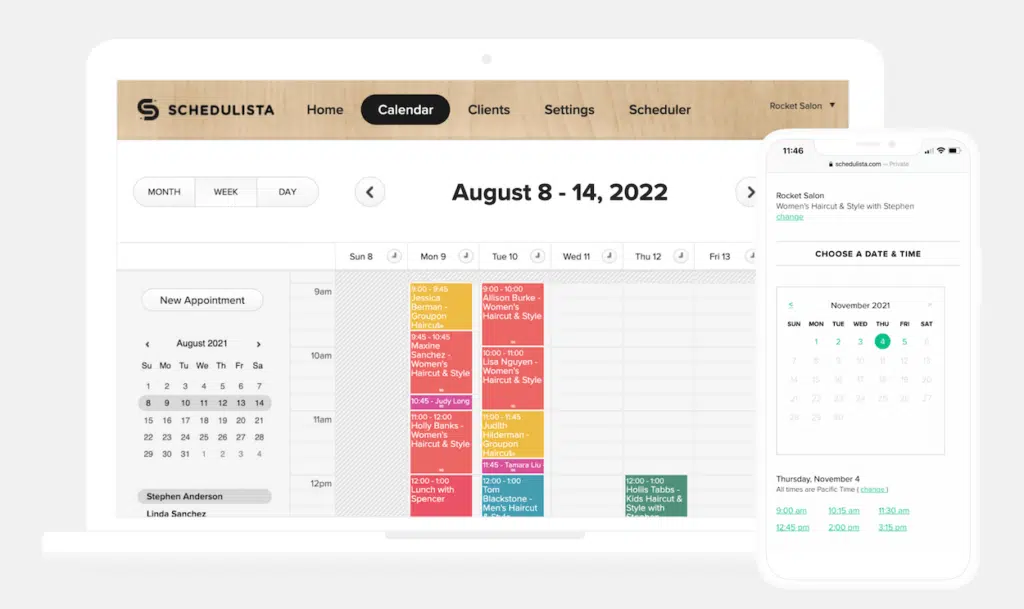
Availability:
Schedulista’s appointment scheduling software is web-based and has apps for iPhone and Android.
Testimonial:
I love Schedulista! As a small business, the price is right, the features awesome. I have referred many a student and colleague to Schedulista as it has streamlined my business and lets me focus on the therapy side of my practice. Brava, Schedulista!
Kayla Garnet R. (Capterra review)
Highlights:
- Direct booking: Allows students or staff to book appointments directly, saving admin time.
- Automated reminders: Sends out email or SMS reminders to reduce no-shows.
- Customizable interface: Personalize to match the institution’s branding or preferences.
- Integration capabilities: Works well with popular calendar platforms for smooth syncing.
- Multiple user roles: Differentiate between staff, student, or admin roles for varied access levels.
Enriching Students
Overview:
Crafting personalized learning experiences is no small task, but Enriching Students makes it seem so. At its core, it’s all about connecting the dots between students’ needs and academic offerings. The result? Tailored learning paths that truly resonate.
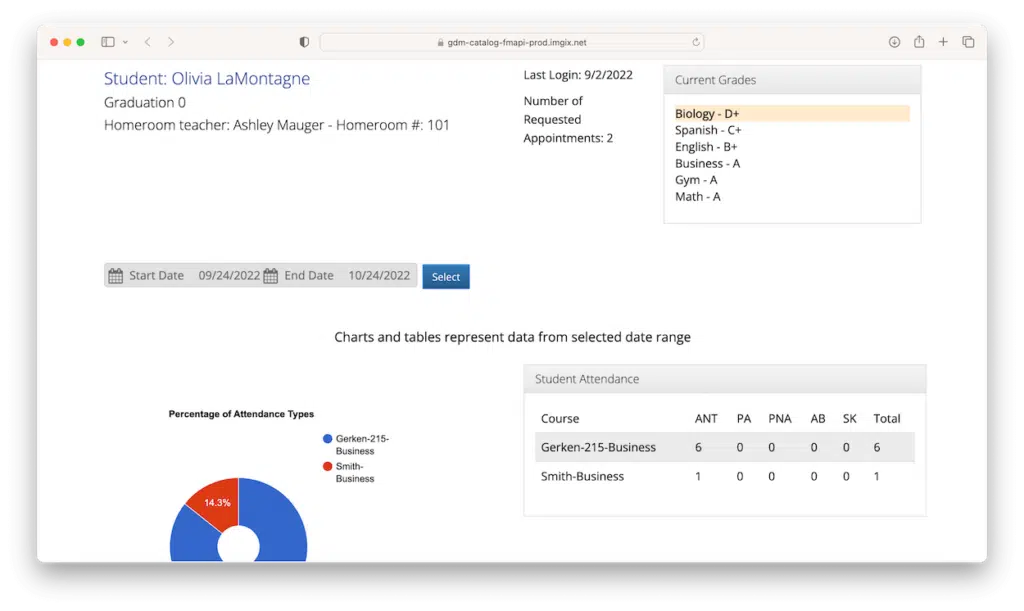
Availability:
This class scheduling software is primarily web-based.
Testimonial:
…we are enjoying the stability and ease-of-use of our program. Initial data from our first semester of use has been positive.
Tom Pavlidis (source: https://www.enrichingstudents.com)
Highlights:
- Flexible scheduling: Adjust schedules according to student needs and teacher availability.
- Reporting tools: Offers insights into student progress and attendance.
- Easy communication: Built-in tools for educators to communicate with students or parents.
- Time block customization: Set and manage distinct periods for different activities.
- Data-driven decisions: Analytic support decisions on interventions and enrichment.
PowerSchool
Overview:
PowerSchool doesn’t just skim the surface; it dives deep into the world of student management. From grades to attendance and beyond, it serves as a unified education technology platform catering to administration and instruction in educational institutions.

Availability:
Available as a web-based platform, PowerSchool’s pricing is adaptive, fitting the diverse needs of schools and districts.
Testimonial:
PowerSchool’s Student Information System and the company’s broader product portfolio has enhanced our ability to effectively communicate with parents and other educators within the district, all while decreasing the amount of time spent on other administrative duties.
Ron Cone (source: https://www.powerschool.com/)
Highlights:
- Holistic student information system: Comprehensive data from grades to health records.
- Customizable gradebook: Tailor grading systems according to curriculum or institutional policies.
- Parent and student portals: Transparent access to grades, attendance, and assignments.
- District-wide analytics: Gives insights into performance, attendance, and more.
- Adaptable modules: Choose from various modules for functionalities like HR, finance, or special education.
Classter
Overview:
By offering a platform for educational processes, Classter ensures everything from admissions to grading rides on the same track. The platform integrates academic, administrative, and communication tools in one unified space, simplifying the educational process for all participants.
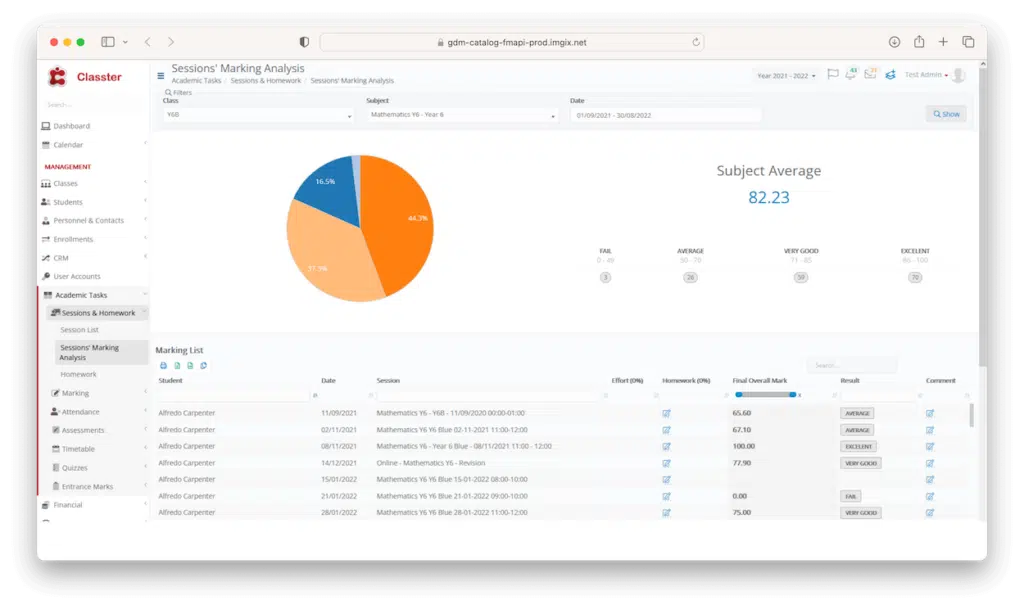
Availability:
Primarily web-based scheduling software for schools, Classter is also available as an app for Android and iOS.
Testimonial:
It has improved my organization and allows me to establish better relationships with the parents of the students, as they are involved in the training process of their children’s school activities and the follow-up. We have also been able to verify that the performance of the students has increased. It is a very robust tool, it has allowed us to establish more effective work methodologies and we are pleasantly satisfied with its functionality.
Omar R. (Capterra review)
Highlights:
- Modular structure: Allows you to choose only the features and tools relevant to your institution’s specific needs.
- Parent and student engagement: Provides dedicated portals to access grades, timetables, and communication.
- Integrated billing and invoicing: Allows you to manage finances directly within the platform.
- Curriculum management: Lets you organize, monitor, and evaluate academic content with ease.
- Attendance tracking: Provides real-time monitoring and reporting on student attendance.
Alma SIS
Overview:
Alma SIS focuses on simplifying administrative tasks while offering valuable insights into student performance. Acting as the bridge between students, educators, and parents, Alma SIS creates a cohesive narrative of academic journeys. In short, Alma makes sense of the numbers, turning data into actionable insights.
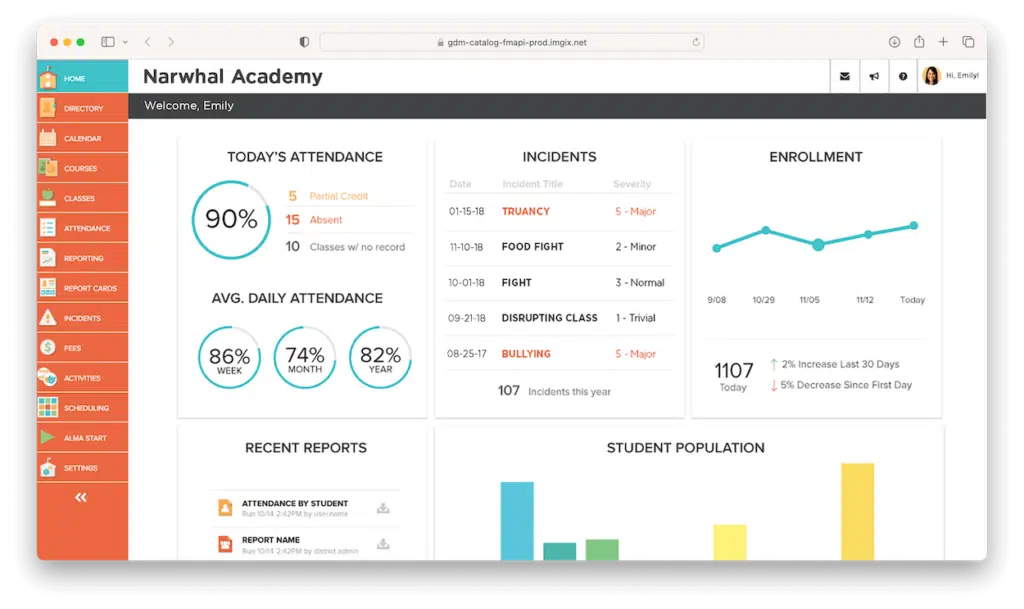
Availability:
Alma is available through a web portal on any device.
Testimonial:
I like that Alma has so many reports that I can generate to look at different aspects of the school such as progress reports, attendance, missing assignments, and so on. I also love how easy it is to create your own report card templates and create your own grading systems and monitor everything from one platform. Parent communication is also very easy!
Aisha B. (G2 review)
Highlights:
- Dynamic reporting: Customizable reports to track student performance, attendance, and more.
- Communication tools: Built-in messaging system for smoother teacher-parent-student collaboration.
- Centralized dashboard: Access all features and data from a unified interface.
- Flexible grading: Supports traditional and standards-based grading systems.
- Calendar integration: Sync important dates, events, and schedules with popular calendar platforms.
Canvas
Overview:
Canvas is a modern LMS that encourages and facilitates digital learning. It offers a blank slate where educators and students can collaboratively paint their academic dreams. With tools for assignments, discussions, and feedback, it’s the canvas on which educational success is sketched.
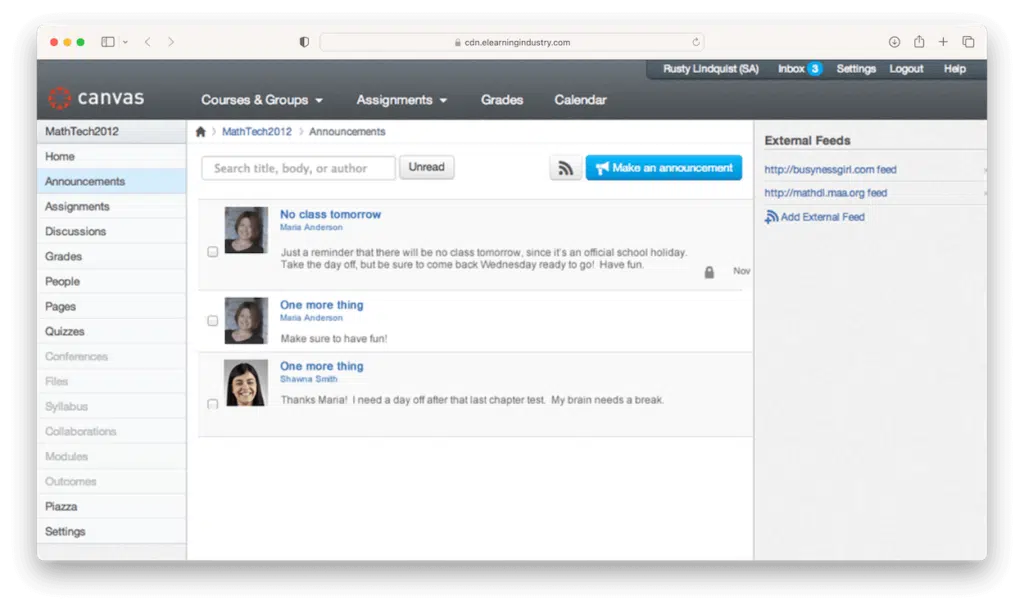
Availability:
Canvas is available on the web, iOS, and Android.
Testimonial:
I loved that Canvas was easy to use. Even though I had never used Canvas before, I jumped in and was able to do everything I needed pretty quickly. I had all of the features I needed but it wasn’t difficult to use.
Verified review (source: https://elearningindustry.com/)
Highlights:
- Interactive course design: Embed videos, quizzes, and interactive content directly into courses.
- Seamless integrations: Works effortlessly with many educational tools and platforms.
- Peer reviews: Facilitates student-to-student feedback and evaluations.
- Mobile learning: Fully functional mobile apps ensure learning on-the-go.
- Collaborative workspaces: Students and educators can collaborate in real time on projects and discussions.
Jotform
Overview:
Jotform is an online form builder, allowing educational institutions to create and share digital forms with ease. Jotform simplifies the process of creating and administering registrations, surveys, or quizzes, one form at a time.
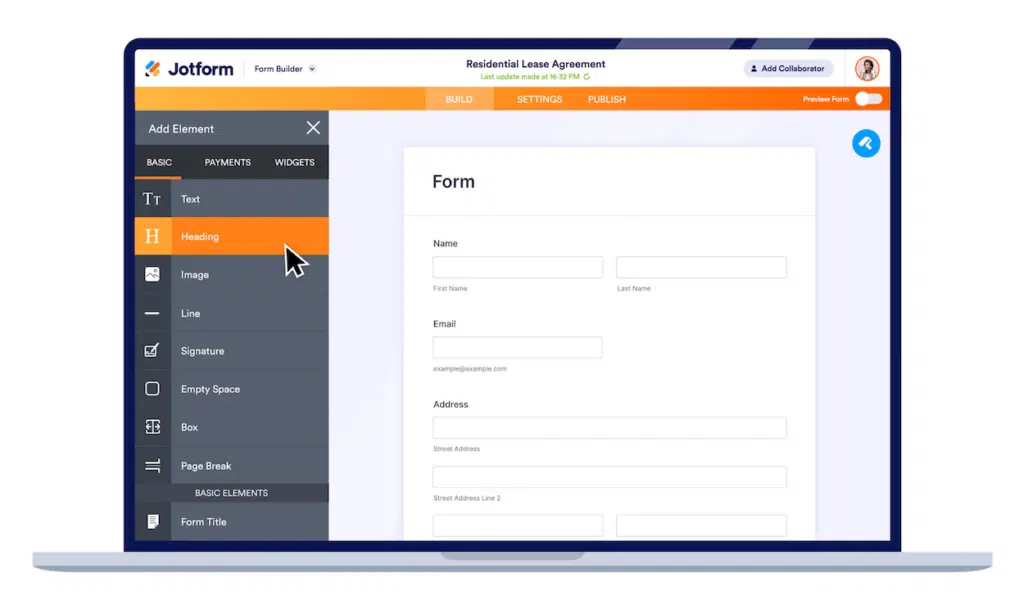
Source: https://www.getapp.com/
Availability:
Jotform is a web-based application and has apps on both Google Play and the App Store.
Testimonial:
The improved back-end features, the reporting functions, and the integrations have really made me like this platform. The nonprofit discount and the overall affordability have been great.
Nathaniel B. (GetApp review)
Highlights:
- Drag-and-drop builder: Easily create forms without any technical know-how.
- Integration capabilities: Connect forms with popular platforms and databases.
- Responsive design: Forms are accessible and functional across devices.
- Advanced security: Data is collected and stored securely.
- Custom branding: Customize forms in line with your institution’s branding guidelines.
Moodle
Overview:
Moodle is a globally recognized, open-source LMS designed for both educators and learners. Whether you’re crafting courses or embarking on a virtual learning quest, Moodle makes it feel like a walk in the park. And its digital hub is both friendlier and more educational than your favorite social media site.

Availability:
Moodle is available on the web, with mobile compatibility through its Moodle mobile app for Android and iOS.
Testimonial:
It requires some practice to set up the way you want. Support is very responsive. They offer lots of webinars and Q&A opportunities. It is customizable, I can set up various roles and permissions.
Paula C. (source: https://elearningindustry.com/)
Highlights:
- Customizable course design: Create courses that suit the needs of educators and learners.
- Active community: Benefit from regular updates, plug-ins, and community support.
- Assessment tools: Versatile quiz and grading mechanisms to evaluate student progress.
- Collaborative tools: Forums, wikis, and chat allow learners to engage with content and each other.
- Multilingual capability: Supports a wide range of languages, accommodating global learners.
iGradePlus
Overview:
iGradePlus isn’t just a typical gradebook; it’s a system for effortless school management with useful scheduling features. Grading, attendance, and communication are all sorted with this platform, which turns the daily grind into pure efficiency.
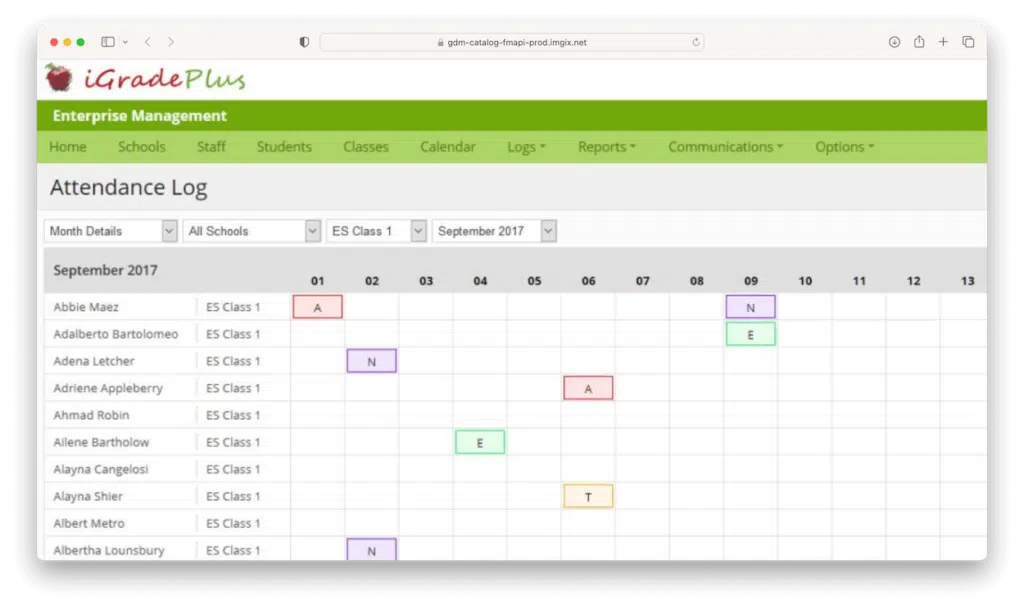
Availability:
Staff and students can access iGradePlus using a web portal.
Testimonial:
What I like about this software is that it is simple to use and just gets the job done without trying to overwhelm with irrelevant features. I also like how my student can see their progress easily.
Prof. Kelly W. (GetApp review)
Highlights:
- Comprehensive grading: Supports weighted grades, standards-based grading, and more.
- Parent and student portals: Facilitates engagement and communication between home and school.
- Attendance management: Record and report on student attendance effortlessly.
- Detailed reports: Generates insightful reports on performance, attendance, and behavior.
- Data import/export: Seamlessly move data in and out of the system for flexible use.
Schoology
Overview:
Schoology by PowerSchool is an LMS focused on helping K-12 schools to enrich their students’ learning. It aims to improve communication and support rich personalized and teacher-led learning experiences.
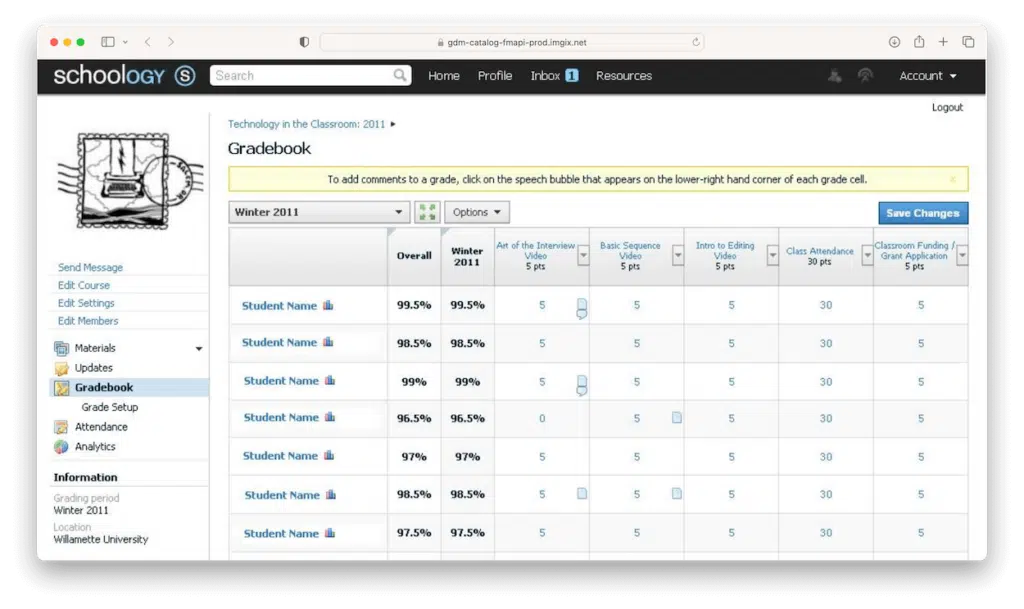
Availability:
Schoology is available on the web as well as on iOS and Android devices.
Testimonial:
I love Schoology. The few times I needed support, the individuals I spoke with were amazing. The features and ease of Schoology outshines other LMSs on the market. Other than the couple of quirks I mentioned above, this is a product good for a wide range of ages and courses.
Amy (source: https://www.softwareadvice.com/)
Highlights:
- Interactive media: Embed multimedia content directly into lessons.
- Assessment management: Create, manage, and score using diverse assessment types.
- Personalized learning: Customize learning paths for individual student needs.
- Integration: Contains numerous pre-integrated tools to enhance learning and classroom management.
- Collaborative spaces: Facilitates group projects and discussions in dedicated digital spaces.
Ad Astra (Astra Schedule)
Overview:
Astra Schedule, Ad Astra’s education scheduling software, is the maestro of higher education planning. By tuning into the rhythm of resources and the beat of academic needs, Astra Schedule transforms campus chaos into harmony. For those in the higher education world, it’s like having a backstage pass to the best gig in town: optimal resource use.
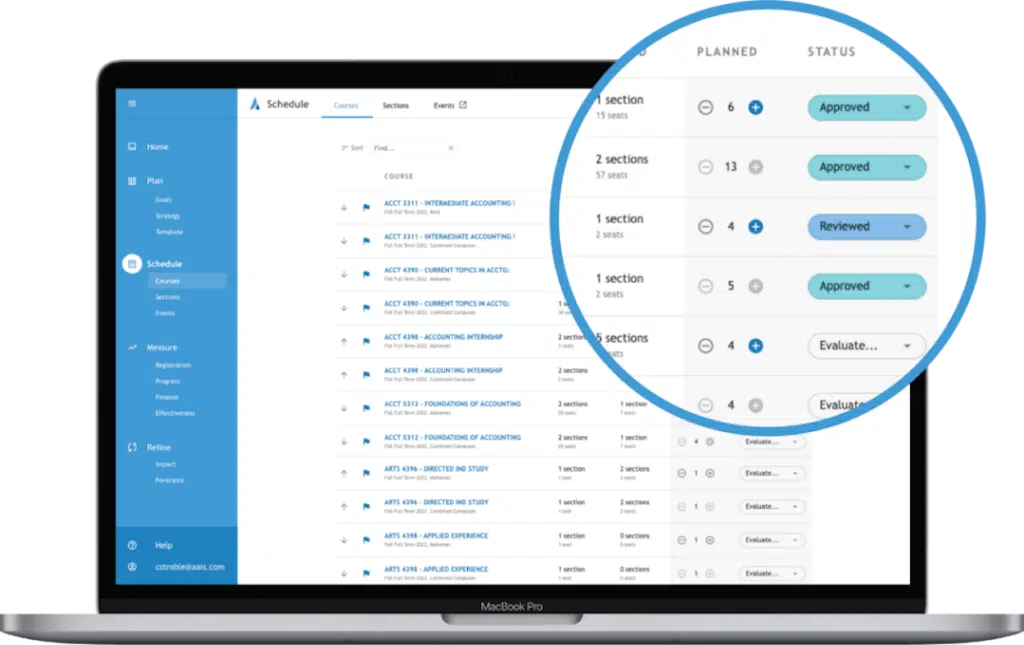
Availability:
Astra Schedule is web-based education scheduling software.
Testimonial:
Astra Schedule is a good classroom scheduling tool. We’ve enjoyed the integration and live syncing of the data, which has been very helpful. Controlling security by the user and by the location provides a lot of options.
Christopher G. (G2 review)
Highlights:
- Data-driven scheduling: Make informed decisions based on real-time data.
- Room optimization: Ensure the most efficient use of campus facilities.
- Conflict resolution: Automated tools to detect and resolve scheduling conflicts.
- Reporting tools: Insightful reports on resource usage, student success, and more.
- Integration capabilities: Synchronize with other institutional systems for a holistic approach.
OpenEduCat
Overview:
OpenEduCat streamlines educational management from admission to graduation. With its range of features and sleek design, managing a school feels less like work and more like play. Whether it’s enrolling the next Steve Jobs or keeping track of the library, OpenEduCat is the main act in the school management show.
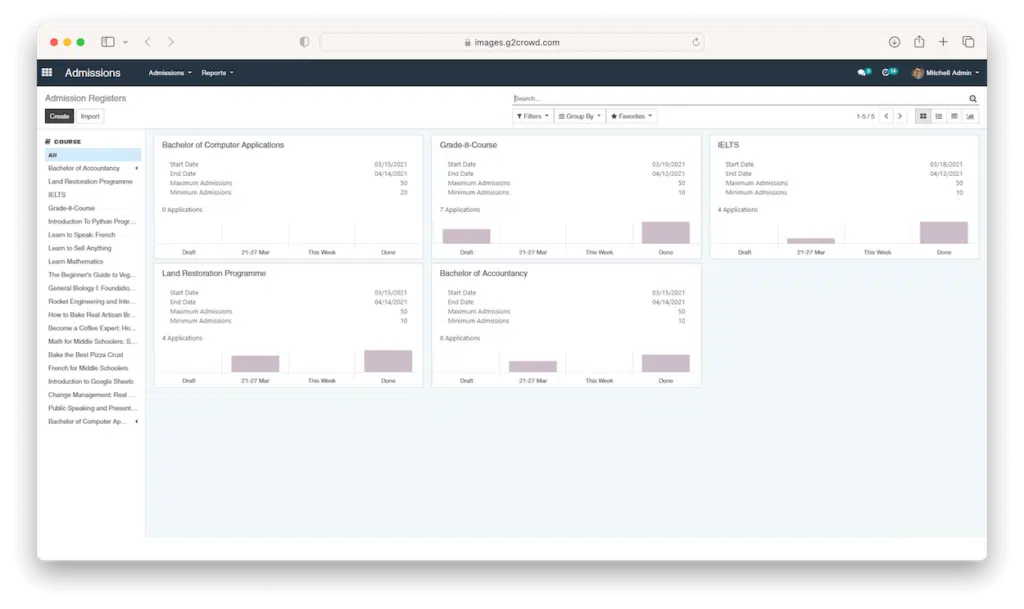
Availability:
OpenEduCat is open-source, web-based college scheduling software, with mobile apps available for Android and iOS.
Testimonial:
What do I like about OpenEduCat? It is open source. Covers most of any educational institution’s needs. Good support from the company and community. Web-based applications can be hosted locally as well as on the cloud.
Firas F. (G2 review)
Highlights:
- Admission management: Automate and streamline student admissions.
- Library management: Use its digital tools for cataloging, issuing, and tracking books.
- Financial tools: Handle fees, payrolls, and other financial aspects with ease.
- Timetable and scheduling: Efficiently plan academic schedules and allocate resources.
- Online examinations: Create, manage, and grade online tests.
School Scheduling Software: Comparison
After exploring 15 top pieces of educational software, we’ve zeroed in on seven that truly shine. Use the table below to see which one might be the best match for your institution.
| School scheduling software | Key features | Why it stands out |
|---|---|---|
| Google Classroom | – Manage coursework – Distribute assignments – Communicate with students | Integration with Google services; user-friendly interface that’s widely adopted across education sectors. |
| Canvas | – Course creation Gradebook – Customizable learning paths | Comprehensive LMS adopted by institutions from K-12 to higher education. |
| Schoology | – Learning management – Assessment management – Collaboration tools | Known for its comprehensive set of tools tailored to K-12 educators and students. |
| Power | – Student information system (SIS) – Gradebook Attendance | Staple in many schools, especially in the U.S., for its extensive SIS capabilities. |
| Moodle | – Open-source LMS – Customizable courses – Collaboration and communication tools | Global recognition due to its open-source nature, offering vast customization options. |
| Virto Calendar App for Education | – Centralized scheduling – Integration with Microsoft tools – Syncs with multiple calendar sources including Google Calendar and iCal | Streamlined academic and administrative planning through one user-friendly platform, fully integrated with Microsoft 365. |
| Alma SIS | – Modern SIS Intuitive interface – Grading, attendance, and communication tools | Modern interface and a comprehensive range of features beneficial for both educators and administrators. |
That’s a quick summary of seven standout school scheduling and management gems. Whichever you lean towards, remember that the right tool can make all the difference in improving your institution’s class scheduling routine. Are you ready to embrace technology?
Conclusion
We’ve talked a lot about the benefits of software for class scheduling. Simply put, it makes things run smoother. Whether it’s organizing classes, meetings, or events, good software helps save time and reduce mix-ups. While every college has unique needs, they all share one common desire: more seamless operations.
If there’s a single takeaway from our exploration, it’s this: don’t let your institution get left behind in the digital age. Embracing scheduling software like the overviewed solutions can drive productivity, clarity, and overall excellence. Among them, the Virto Calendar app for education stands out, promising a scheduling experience that aligns well with modern academic requirements.
So start your demo today to explore the potential of these tools, and make Virto your first port of call. Should questions or curiosities arise, we’re just a message away. Elevate your institution’s scheduling and let technology amplify your educational impact.



